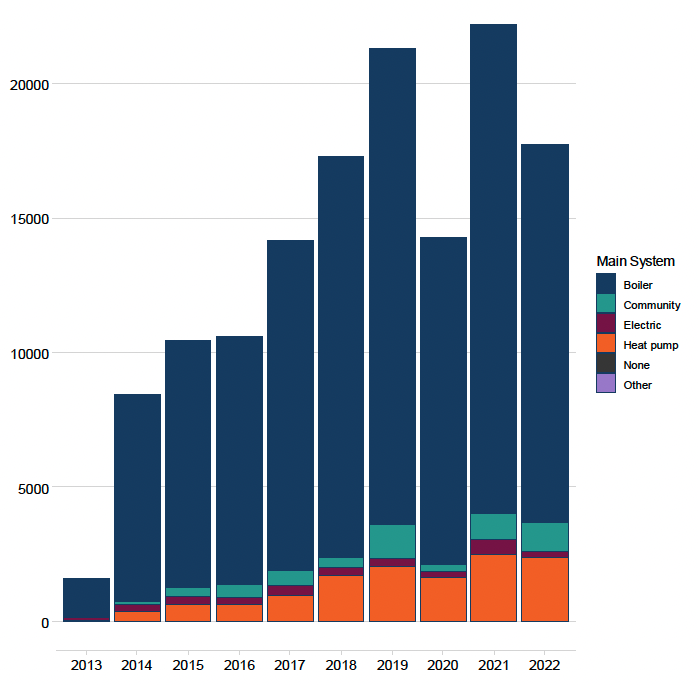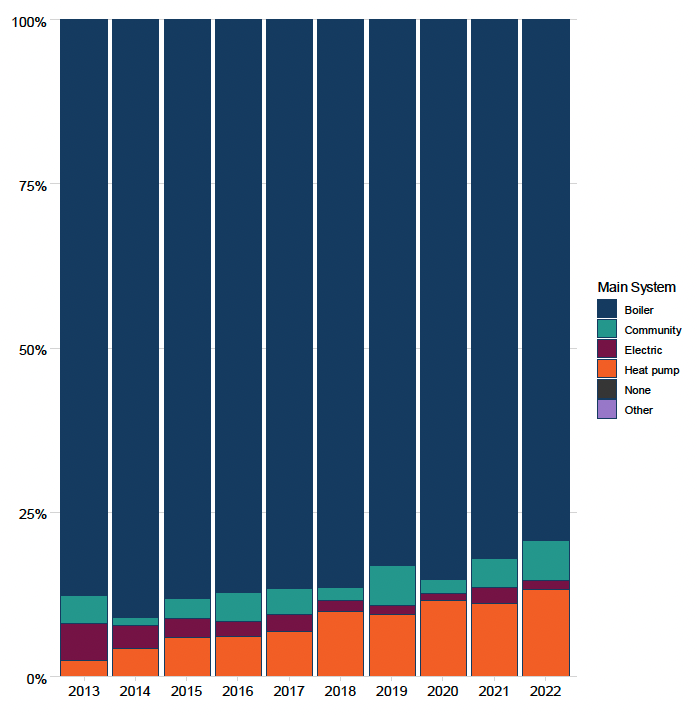New Build Heat Standard 2024: business and regulatory impact assessment
Business and regulatory impact assessment (BRIA) in consideration of the introduction of the New Build Heat Standard (NBHS). Looking in detail at the economic impacts of moving to Zero Direct Emissions heating systems in all new buildings.
This document is part of a collection
2. Purpose and Intended Effect
2.1 Background
1. In October 2019, the Climate Change (Emissions Reduction Targets) (Scotland) Act 2019 received Royal Assent and was commenced in March 2020, setting annual and interim emissions reduction targets for Scotland on a trajectory to net zero emissions by 2045. These targets include the interim goal of a 75% reduction in emissions by 2030 (relative to the baseline period[1]).
2. Published in October 2021, the Scottish Government's Heat in Buildings Strategy[2] sets out the policy landscape surrounding the decarbonisation of space and water heating in Scotland. The NBHS was one such policy outlined as part of that Strategy.
3. Direct emissions from buildings accounted for almost 22% (8.6 MtCO2e) of Scotland's territorial greenhouse gas (GHG) emissions in 2020, the latest year for which statistics are available.[3] Of this, 7.7 MtCO2e was attributable to residential, commercial, and public combustion.[4] Meeting our legally-binding targets will require action to be taken with regard to reducing emissions from the existing stock of buildings through fabric upgrades and conversion to zero direct emissions heat, as well as ensuring new buildings do not add to the problem. This secondary legislation, The Building (Scotland) Amendment Regulations 2023, aims to address the latter.
4. As they currently stand, building standards do not prohibit the use of direct emissions heating systems, such as gas boilers. However, recent amendments to building standards have been designed to encourage the use of alternative, zero direct emissions heating (ZDEH) systems. In particular, buildings constructed with a direct emissions heating system will be required to achieve challenging targets related to both energy performance and building emissions while information must be provided on how a zero direct emissions heating system could be easily retrofitted to the building in future. This lays the groundwork for the forthcoming NBHS, whilst also minimising emissions from new-builds in the meantime.
5. This policy coincides with recommendations made by the Climate Change Committee (CCC), our independent statutory adviser on climate change. "The Scottish Government should: Legislate to prohibit the use of 'direct emissions heating systems' from 2024 in new residential and non-residential buildings" (page 101).[5]
2.2 Objective
6. The objective of this policy is to prevent greenhouse gas emissions associated with delivering space heating, hot water, and cooling in new buildings, as well as conversions of existing buildings under specific circumstances. This will cover both domestic and non-domestic buildings applying for a building warrant from 1 April 2024 onward. This will be achieved through the prohibition of heating system installations that are not compliant with the NBHS. These non-compliant systems are termed Direct Emissions Heating (DEH) systems throughout this BRIA.
7. As laid out above in paragraph 3, the main intended outcome of this standard is that space and water heating, as well as cooling, within the curtilage of new buildings applying for a warrant from 1 April 2024 will not contribute to Scotland's territorial greenhouse gas emissions. Secondary outcomes include mitigation of air pollution as well as a scaled-up market for NBHS-compliant heating technologies, which in turn may be indirectly beneficial in lowering the cost of tackling emissions associated with the already existing stock of buildings which will require technology retrofits in future.
8. The Building (Scotland) Amendment Regulations 2023 sets out that a "direct emissions heating system", in relation to a building, means a fixed combustion appliance installation (other than a fixed combustion appliance installation which is a source of production from which thermal energy is distributed by a heat network) the purpose of which is to produce thermal energy by which space within the building is heated or cooled, or by which hot water is made available in the building, and which—
a) is located within the building, or curtilage of the building, and
b) during normal operation produces more than a negligible level of greenhouse gas emissions at the point of production of that thermal energy.
9. This policy has interaction effects with the Scottish Government's Housing to 2040 Vision,[6] the Fuel Poverty Strategy,[7] as well as Scottish building standards.[8]
10. The UK Government has signalled its ambition to ensure that all new buildings in England are net zero-ready from 2025 through their Future Homes Standard (FHS) and Future Buildings Standard (FBS).[9]
2.3 Rationale for Government Intervention
11. Business-as-usual. As Figure 1 below shows, DEH systems are still installed as the main heating system in the vast majority of new-build homes. Over the past five years (2018 to 2022), around 80% of the new homes constructed use mains gas boilers as their primary heating fuel and system, and a further 2.5% use either oil or LPG.[10] This compares with 81% and 6% in the wider existing residential stock, respectively.[11] Over the next 10 years, these households may emit an estimated cumulative 0.9 MtCO2e. By 2045, all homes will have to replace their heating systems with a ZDEH alternative, with the Scottish Government announcing its intention to introduce regulations to require this from 2025 onward.[12], [13] We must ensure that new properties avoid the need to undergo expensive retrofit to adopt ZDEH systems[14] in future and avoid locking-in unabated emissions prior to their retrofit.

Notes: Data on each current record held on the Scottish EPC Register from Q1 2013 to Q3 2022.[15] Number of EPCs does not match National Statistics for new housing published by the Scottish Government.[16]
12. While there has been an increasing trend in homes adopting ZDEH technologies in recent years (as is shown in Figure 2 below),[17] discussions with stakeholders as part of our Scottish Firms Impact Test (SFIT) indicated less progress would be made in the absence of the NBHS being implemented. This regulatory standard would see future columns in Figure 2 entirely comprised of community (including heat networks), electric, or heat pump heating systems, alongside (potentially) hydrogen boilers - if the market can deliver them. Indeed, this recent rise in ZDEH installations in new homes may be a result of the market anticipating, and thus future-proofing homes against, the prospect of future retrofits being required.

Notes: Data on each current record held on the Scottish EPC Register from Q1 2013 to Q3 2022.[18]
13. Imperfect information. Related to the above point on the market partially anticipating the prospect of future retrofits being mandated, it may be possible that some segment of the market is already aware that DEH systems will be prohibited in the future and may be paying a premium currently to future-proof against this. However, this leaves another segment of the market which may not be aware that such retrofits will be on the horizon. Had they known, they may have chosen to purchase a new-build home with a ZDEH system. For example, recent research conducted by BMG Research for the Scottish Government found that 54% of respondents were uninformed about the Scottish Government's target to convert at least one million homes to ZDEH by 2030.[19] Likewise, polling conducted for Nesta found that 88% of respondents underestimated annual gas boiler emissions.[20] A pre-condition of market efficiency is that all participating market actors possess the information they need to make an informed transaction.[21]
14. System lock-in. Assuming heating technologies have a typical lifetime of 15-20 years, there is a risk that new buildings will be constructed with DEH technologies installed post-2025 or -2030, leading to premature scrappage of these systems to reach net zero emissions by 2045. In addition, adding to the stock of buildings that must then be retrofitted at a later date defers stimulating and building up the ZDEH supply chain until said later date, and may consequently lead to a higher degree of disruption to consumers in the future when a more rapid rollout of ZDEH technologies is needed. As discussed above, there is not only technological lock-in, but also lock-in of unabated emissions if new-builds are allowed to continue adopting DEH systems.
15. Negative externalities. DEH systems are associated with unpriced negative "externalities" that adversely impact societal wellbeing, both now and in the future. For example, when a user combusts fossil fuels for heat, they do not themselves face the full cost to society this imposes. These negative impacts include air pollution as well as GHG emissions which contribute to anthropogenic climate change. The negative externalities associated with climate change are explored extensively within the fields of economics and science.[22], [23], [24], [25] These externalities represent market failures, and as such warrant Government intervention in the market to correct them. They are also a primary reason as to why regulation is being pursued rather than voluntary regulation or self-regulation.
16. Positive externalities. There are also a number of possible positive externalities associated with the uptake of ZDEH systems that the NBHS could nurture. These include innovation spill-over benefits associated with research and development and economies of scale in the ZDEH supply chain, as well as learning-by-doing benefits which promote productivity.[26], [27] Encouraging demand for ZDEH systems could have the potential benefit of reducing their costs and consequently lowering the total cost of retrofitting the existing stock of buildings. Such innovation spill-over effects could also spur innovation in other sectors of the economy also.
17. Recommended by the Climate Change Committee (CCC). Building regulations and standards are an appropriate course of action for addressing the above market failures in new-builds. Indeed, the Climate Change Committee (CCC) have recommended such actions be taken. "We have previously recommended that Government strengthen new build standards to future-proof for low-carbon heating, with a further tightening in 2025 to support deployment of low-carbon heat" (page 52).[28]
18. Alignment with National Performance Framework (NPF). With regard to our National Performance Framework (NPF),[29] the NBHS aims to contribute positively to four of the National Outcomes, with relevant National Indicators for progress towards these Outcomes listed in the footnotes:
- We value, enjoy, protect, and enhance our environment;[30]
- We have a globally competitive, entrepreneurial, inclusive, and sustainable economy;[31]
- We are open, connected and make a positive contribution internationally;[32] and
- We have thriving and innovative businesses, with quality jobs and fair work for everyone.[33]
19. Alignment with National Strategy for Economic Transformation (NSET). The NBHS seeks to align with our National Strategy for Economic Transformation (NSET),[34] in particular our "greener ambition" to demonstrate global leadership in delivering a just transition to a net zero, nature-positive economy, and rebuilding natural capital.
Contact
Email: 2024heatstandard@gov.scot
There is a problem
Thanks for your feedback